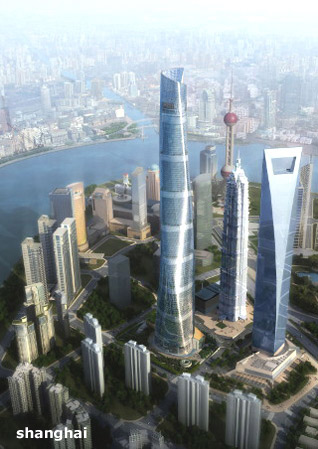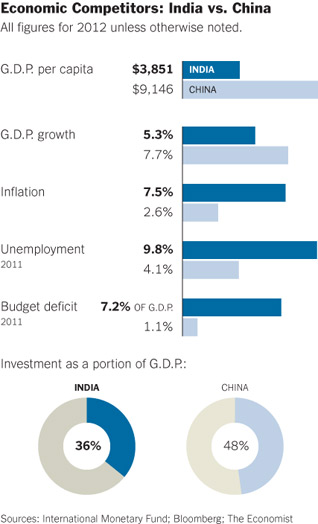Current Events
India is Losing the Race
STEVEN RATTNER
As recently as 2006, when I first visited India and China, the economic race was on, with heavy bets being placed on which one would win the developing world sweepstakes.
Many Westerners fervently hoped that a democratic country would triumph economically over an autocratic regime.
Now the contest is emphatically over.
China has lunged into the 21st century, while India is still lurching toward it.
That’s evident not just in columns of dry statistics but in the rhythm and sensibility of each country. While China often seems to eradicate its past as it single-mindedly constructs its future, India nibbles more judiciously at its complex history.
Visits to crowded Indian urban centers unleash sensory assaults: colorful dress and lilting chatter provide a backdrop to every manner of commerce, from small shops to peddlers to beggars.
That makes for engaging tourism, but not the fastest economic development.
In contrast to China’s full-throated, monochromatic embrace of large-scale manufacturing, India more closely resembles a nation of shopkeepers.
To be sure, India has achieved enviable success in business services, like the glistening call centers in Bangalore and elsewhere. But in the global jousting for manufacturing jobs, India does not get its share.
Now, after years of rocketing growth, China’s gross domestic product per capita of $9,146 is more than twice India’s. And its economy grew by 7.7 percent in 2012, while India expanded at a (hardly shabby) 5.3 percent rate.
China’s investment rate of 48 percent of G.D.P -- a key metric for development -- also exceeded India’s. At 36 percent, India’s number is robust, particularly in comparison with Western countries. But the impact of that spending can be hard to discern; on a recent 12-day visit to India, not many rupees appeared to have been lavished on Mumbai’s glorious Victoria Terminus, also known as Chhatrapati Shivaji Terminus, since it was constructed in the 1880s. Parts of Mumbai’s recently built financial district -- Bandra Kurla Complex -- already look aged, perhaps because of cheap construction or poor maintenance or both. It’s hardly a serious competitor to Shanghai’s shiny Pudong.
China has 16 subway systems to India’s 5. As China builds a superhighway to Tibet, Indian drivers battle potholed roads that they share with every manner of vehicle and live animal. India’s electrical grid is still largely government controlled, which helped contribute to a disastrous blackout last summer that affected more than 600 million people.
Yet Morgan Stanley stands resolutely behind its 2010 prediction that India will be growing faster than China by the middle of this decade.
It isn’t going to happen, India’s better demographics notwithstanding.
For one thing, many of India’s youths are unskilled and work as peddlers or not at all. For another, despite all the reforms instituted by India since its move away from socialism in 1991, much more would have to change. Corruption, inefficiency, restrictive trade practices and labor laws have to be addressed.
Democratic it may be, but India’s ability to govern is compromised by suffocating bureaucracy, regular arm-wrestling with states over prerogatives like taxation and deeply embedded property rights that make implementing China-scale development projects impossible. Unable to modernize its horribly congested cities, India’s population has remained more rural than China’s, further depressing growth.
“China” and “corruption” may be almost synonymous to many, but India was ranked even worse in corruption in Transparency International’s annual Corruption Perceptions Index. At its best, the Indian justice system -- a British legacy -- grinds exceptionally slowly.
To be sure, summary executions don’t occur in India, and its legal system is more transparent and rule-based than China’s. But a recent visit coincided with the tragic gang rape of a young Indian woman that led to her death; the government’s ham-handed initial response was to ban protesters from assembling and impound vans with tinted windows like the one in which she was abducted.
India’s rigid social structure limits intergenerational economic mobility and fosters acceptance of vast wealth disparities. In Mumbai, where more than half the population lives in slums often devoid of electricity or running water, Mukesh Ambani spent a reported $1 billion to construct a 27-story home in a residential neighborhood.
Don’t get me wrong -- I am hardly advocating totalitarian government. But we need to recognize that success for developing countries is about more than free elections.
While India may not have the same “eye on the prize” so evident in China, it should finish a respectable second in the developing world sweepstakes. It just won’t beat China.
[Courtesy: New York Times]
February 17, 2013
Conversation about this article
1: Kanwarjeet Singh (USA), February 17, 2013, 1:24 PM.
It is referred to as the 'sins of the fathers'. Just one such sin was committed by Narasimha Rao - when the Sikhs brought outsourcing to India, Chandigarh had the best infrastructure that supported satellite links and a planned city with a great climate to support international business; not to mention the chance to have a new international airport with all the land near Mohali. Narasimha Rao did not allow this to happen; instead forced the outsourcing companies to invest in his home city of Bangalore. None of these non-Sikhs ever liked Punjab being the state with the highest GDP - the Green Revolution would have given way to a technological revolution. Many of the companies which wanted to set up business in India at that time were turned away and went to South East Asia. The rest is history. Also, besides IT work what else has progressed in India? There is no mental attitude to succeed - being a superpower requires major change in the thought-process - India's thinking still exists in the 14th century.
2: Baljit Singh Pelia (Los Angeles, California, U.S.A.), February 17, 2013, 3:10 PM.
Mohali was called ELTOP - Electronic Town Of Punjab. Hard drives were assembled and manufactured there in the seventies. Busloads of youngsters were brought in for the work. It could have set the manufacturing race with China's city of Shenzen. India's self-serving politicians, seeing the huge potential, tried moving this industry to Faridabad and Bangalore instead, losing crucial advantage to China. Had the Indians not had the English language advantage, the software industry too would have gone elsewhere. This advantage will soon be lost as well as China enforces English learning into it's education curriculum.
3: Baldev Singh (Bradford, United Kingdom), February 17, 2013, 5:59 PM.
I wonder if Kanwarjeet Singh has been to Chandigarh recently? Des men and women of Hindustan are corrupting Punjab as well. Urinating in public is now rife, even in the 'top' areas of Chandigarh and in broad daylight too! If Punjab wants a 'Technological Revolution', it has to get rid of desi practices.
4: Harpal Singh (Sydney, Australia), February 18, 2013, 1:41 AM.
I am not sure how to put it without sounding too negative, however one does tend to have a better grip on reality about the land/country and its workings (including shortcomings), when one is brought from ground up in that country. I lived 20 of my first years in India and never believed India was even in the race. I think it wasn't much more than wishful thinking on part of Indians or a deliberate contender (India) planted by America, not only to weaken the Chinese psyche, but also push back the day the world wakes up to the singular might of China. The fact always was, as it is now becoming apparent since the dust is settling, that India is losing the race or, as for the ones who experienced India first hand and long enough: India was never in the race!
5: Dr Birinder Singh Ahluwalia (Toronto, Ontario, Canada), February 18, 2013, 7:25 PM.
I am just curious, given the breath and depth of corruption that is being touted in many countries, not just in India or Asia or Africa ... are we wise to rely upon the numbers and statistics extolled in this article? With jest, I recall during the last US Presidential elections, some ex top notch CEO (of, I think, the GE conglomerate) questioned the US Labor Dept. employment numbers (in a futile attempt to bolster Mitt and undermine President Obama); his dissertation and debate with Ali Velshi from CNN was hilarious to watch.
6: Hardev Singh (Richmond Hill, Ontario, Canada), February 19, 2013, 12:14 AM.
Dr Birender Singh ji Ahluwalia, your jest and questioning the statistics do not spare India from the pathetic state of its environment, corrupt governance, corrupt politicians, lack of rule of law and the absence of timely execution, large scale slum dwelling, poor infrastructure and, yes, rapes galore! Does the common man need statistics to find out how bad the situation really is?




